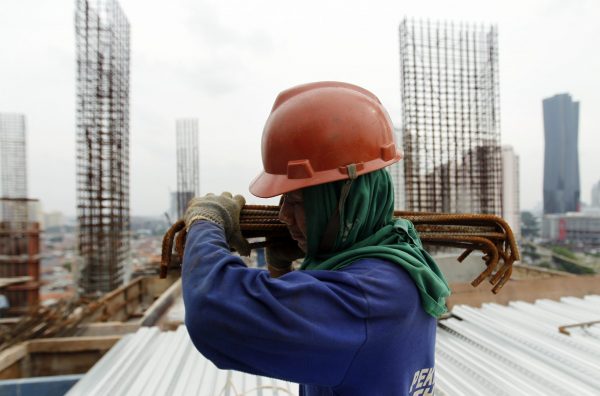Given Indonesia’s cumbersome regulatory environment, financial constraints and propensity for economic nationalism, using the country’s state-owned enterprises (SOEs) to build infrastructure quickly was arguably a practical necessity on Jokowi’s part. But SOE-usage crowds out private capital, increases the potential for cronyism and corruption and creates projects — such as the Kertajati airport in West Java — with limited or questionable economic value.
When he entered office in 2014, Jokowi promised 7 per cent annual GDP growth. When the economy subsequently grew at roughly 5 per cent in 2014, it was considered disappointing, even though it was still one of the highest rates of growth in the world over that time period. From 2011 to 2016, year-on-year GDP growth was on a downward slope in 2016, Indonesia’s growth rate stabilised at 5 per cent even as global demand for commodities, which helped sustain economic momentum during the previous administration, was cooling off.
With exports as a share of GDP declining since the early 2000s, growth in the country’s fixed capital stock picked up the slack. Fixed capital formation made up 23.6 per cent of GDP in 2005, increasing to 32.3 per cent by 2018. Along with strong household consumption, fixed capital formation has been one of the main engines of Indonesia’s economic output during Jokowi’s first term.
Much of this growth in fixed capital has been buoyed by SOEs, particularly those that are focused on infrastructure and public goods. The total assets of nine major infrastructure-oriented SOEs — airport operators Angkasa Pura I & II, the five largest state-owned construction companies, toll road operator Jasa Marga and state-owned railway company Kereta Api Indonesia — totalled Rp 119 trillion (US$8.5 billion) in 2013, the year before Jokowi took office. By 2017, their combined assets had increased to Rp 432.5 trillion (US$30.8 billion), a 262 per cent increase in assets over four years.
This dramatic acceleration in SOE asset growth has translated into real improvements in the country’s lagging infrastructure. According to toll road regulator BPJT, from 2015 to 2018 Indonesia constructed 718 kilometres of new toll roads. By comparison, from 2004 to 2014 only 229 kilometres were built.
In the energy sector, seven mega-power projects of 1000 MW or greater — with a total value of over US$17 billion — reached financial close during Jokowi’s first term and will add 11,000 MW of generating capacity to the grids in Java and Sumatra over the next few years. Several new international airports, with a total value in excess of US$1.5 billion, have also begun operation in Yogyakarta, West Java and Kalimantan.
The question that naturally follows is whether Indonesia can afford such rapid infrastructure growth. The government is legally prohibited from borrowing more than 3 per cent of GDP to finance a deficit in any given year, which constrains its ability to directly fund infrastructure development. SOEs, on the other hand, are under no such constraints and long-term liabilities have ballooned recently, leading to speculation about whether the mounting debt burden will be unsustainable.
Looking again at the big nine SOEs, long-term bank loan and bond debt was Rp 25 trillion in 2014 (US$1.8 billion). By 2017, this debt had reached Rp 87.7 trillion (US$6.3 billion), a 250 per cent increase over three years.
While this is a rapid increase in debt over a short period, the vast majority of this debt is denominated in rupiah, shifting much of the risk of currency depreciation onto the creditors, limiting the primary risk of SOE debt. Additionally, this increase in long-term liabilities is being channelled into productive purposes such as large-scale infrastructure projects, meaning the liabilities are likely sustainable and easily recoverable.
In the short-term, state-led development has accomplished what it set out to. Jokowi turned to Indonesia’s SOEs to build infrastructure quickly, driving fixed capital formation and sustaining GDP growth.
But would private developers have been more efficient agents of development?
Evidence from the renewable energy sector gives us some clues about the efficiency of the private sector in Indonesia. Indonesia has been trying to jump-start growth in solar and wind power since 2013 using a Feed-in Tariff to induce private developers to invest in the sector. Despite offering above market rates, this effort has been disappointing due to poor regulatory architecture and policy confusion. It is necessary in Indonesia for the state to leverage its power to overcome market failures to accelerate development in the short-term.
Going forward, the critical question is whether SOEs will continue to dominate key sectors, and what Indonesia will look like if they do. If SOEs continue to play an outsized role, can inefficiencies be curbed and debt managed sustainably, without turning the sector into a slush fund for cronyism and corruption? There are already troubling signs, with officials at state-owned construction firm Waskita Karya accused of creating 14 fictitious projects and the recent arrest of executives at airport operator Angkasa Pura II on charges of bribery. High-level corruption will seriously handicap SOE-led development going forward.
As he prepares to enter his second term in office, resolving these issues may become some of Jokowi’s most consequential closing acts as president.
James Guild is a PhD candidate in political economy at the S Rajaratnam School of International Studies (RSIS), Nanyang Technological University (NTU), Singapore.

